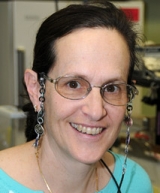Jeanne Mihail

Emeritus Professor
Division of Plant Science and Technology
E-mail: mihailj at missouri dot edu
Office address: 109 Waters Hall
Office phone: 573-882-0574
Lab address: 109 Waters Hall
Lab phone: 573-884-3668
Dr. Mihail’s research focuses on fungi resident in forest systems. A primary focus of her research is the interplay between soil-resident wood decay fungi and tree roots. Past research has focused on the consequences of interspecific competition among wood decay fungi for the species composition of forests. This research has used the wood decay genus Armillaria, which is a key component of Ozark forest ecosystems. Presently, Dr. Mihail is conducting research on the ecological role of natural light production (bioluminescence) by Armillaria and other fungi.
Many forest fungi play roles as carbon recyclers through wood decay. Other forest fungi contribute to the health of woody plants as ectomycorrhizal partners. A second major focus of Dr. Mihail’s research is the cultivation of selected choice, edible forest fungi. Designing and optimizing mushroom cultivation systems will ultimately provide Missouri landowners a new income source and an economical use for forest byproducts.
Bruhn JN, Abright N, Mihail JD. 2010. Forest farming of wine-cap Stropharia mushrooms. Agroforestry Systems 79(2):267-275.
Bruhn, J.N., Mihail, J.D. 2009. Forest farming of shiitake mushrooms: an integrated evaluation of management practices. Bioresource Technology 100:5973-5978
Pruett, G.E., Bruhn, J.N., and Mihail, J.D. 2009. Greenhouse production of Burgundy truffle colonized oak seedlings: Comparison of potting methods. New Forests 37:43-52.
Pruett, G.E., Bruhn, J.N., and Mihail, J.D. Temporal dynamics of ectomycorrhizal community composition on root systems of oak seedlings infected with Burgundy truffle. Mycological Research 112:1344-1354.
Pruett, G.E., Bruhn, J.N., and Mihail, J.D. 2008. Colonization of Pedunculate oak by the Burgundy truffle fungus is greater with natural than pelletized lime. Agroforestry Systems 72;(1):41-50.
Mihail, J.D., Bruhn, J.N., and Bonello, P.E. 2007. Spatial and temporal patterns of morel fruiting. Mycological Research 111;(3):339-346.
Mihail, J.D., and Bruhn, J.N. 2007. Bioluminescence is widespread within the Kingdom Fungi. Opera Mycologica 1:28-33.
Mihail, J.D., and Bruhn, J.N. 2007. Dynamics of bioluminescence by Armillaria gallica, A. mellea, and A. tabescens. Mycologia 99;(3):341-350.
Mihail, J.D., and Bruhn, J.N. 2005. Foraging behaviour of Armillaria rhizomorph systems. Mycological Research 109;(11):1195-1207.
Mihail, J.D., Bruhn, J.N., Leininger, T.D. 2002. The effects of moisture and oxygen availability on rhizomorph generation by Armillaria tabescens in comparison with A. gallica and A. mellea. Mycological Research 106;(6):697-704.
Mihail, J.D., Hung, L.-F., Bruhn, J.N. 2002. Diversity of the Pythium community infecting roots of the annual legume Kummerowia stipulacea. Soil Biology and Biochemistry 34;(5):585-592.
Mihail, J.D., Bruhn, J.N., Meyer, T.R., and Bell F.W. 2002. Pine needle rust effect on Pinus banskiana in response to interspecific plant competition and telial host density. Canadian Journal of Forest Research 32;(8):1372-1380.
Bruhn, J.N., Wetteroff Jr., J.J., Mihail, J.D., Kabrick, J.M., and Pickens, J.B. 2000. Distribution of Armillaria species in upland Ozark Mountain forests with respect to site, overstory species, composition and oak decline. Forest Pathology 30;(1):43-60.
Alexander, H.M., and Mihail J.D. 2000. Seedling disease in an annual legume: Consequences for seedling mortality, plant size, and population seed production. Oecologia 122;(3):346-353.
- Vanderlip M. Show and tell morel. Columbia Tribune (May 28, 2008)
- Uppsala University & the Karl Johan Foundation of Sweden. 2007. Diploma for Contributions to Mycology in the Service of Mankind
- Senior Teaching Award, University of Missouri, College of Agriculture, Food and Natural Resources, 2004